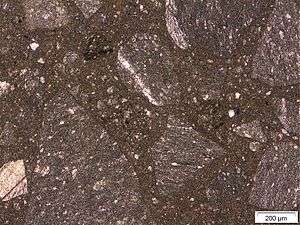Cataclasite

Cataclasite is a type of cataclastic rock that is formed by fracturing and comminution during faulting.[1] It is normally cohesive and non-foliated, consisting of angular clasts in a finer-grained matrix.[2]
Types of cataclasite
There are many varieties of cataclasite, classified by the percentage of the volume formed from the matrix.
- Protocataclasite: protocataclasite is a type of cataclasite in which the matrix takes up less than 50% of the total volume.
- Mesocataclasite: mesocataclasite is a type of cataclasite in which the matrix occupies between 50 and 90 percent of the total volume.
- Ultracataclasite: ultracataclasite is a type of cataclasite characterized by a matrix occupying greater than 90% of the total volume.
- Foliated cataclasite: foliated cataclasite is a type of cataclasite with a significant content of clay. Grades through to fault (clay) gouge when the proportion of clay is greater than 70%.
- Fault breccia: fault breccia is a medium to coarse-grained cataclasite.
Formation
Cataclasite forms by the progressive fracturing of mineral grains and aggregates, a process known as cataclasis. The fracturing continues until a distribution of clast sizes is developed that allows the sliding of clasts past each other, without high enough frictional stresses to further fracture the rock significantly. From then on deformation is accommodated by continued sliding and rolling of fragments, a deformation mechanism known as cataclastic flow. In poorly consolidated or unconsolidated sediments, deformation in fault zones also occurs by rolling and sliding of grains but the porosity of the rock accommodates the resulting strains without significant grain fracturing.
References
- ↑ Oilfield Glossary
- ↑ Brodie, K.; Fette D.; Harte B.; Schmid R. (2007-02-01). "3. Structural terms including fault rock terms" (PDF). Recommendations by the IUGS Subcommission on the Systematics of Metamorphic Rock. pp. 1–14. Retrieved 2009-11-02.